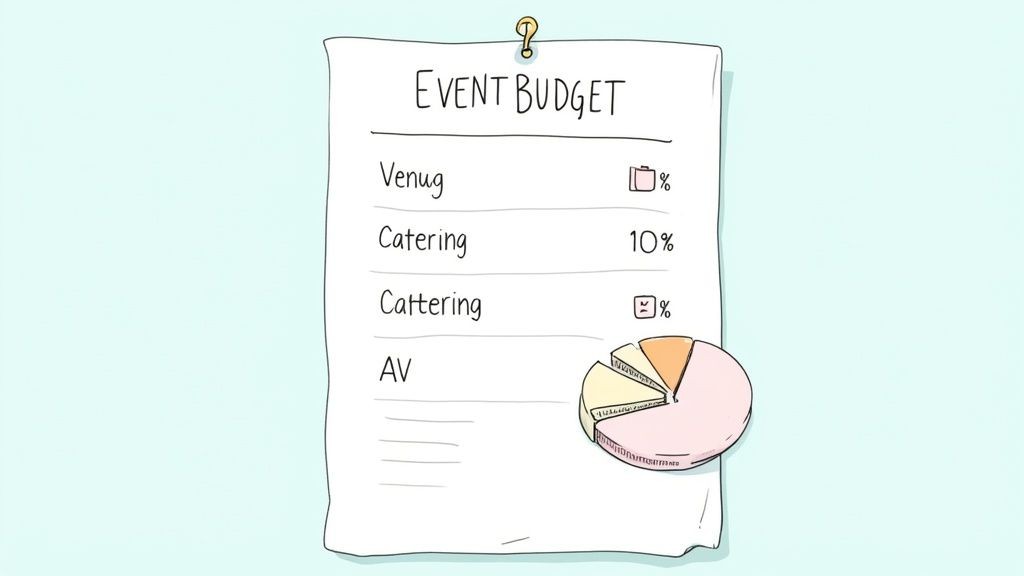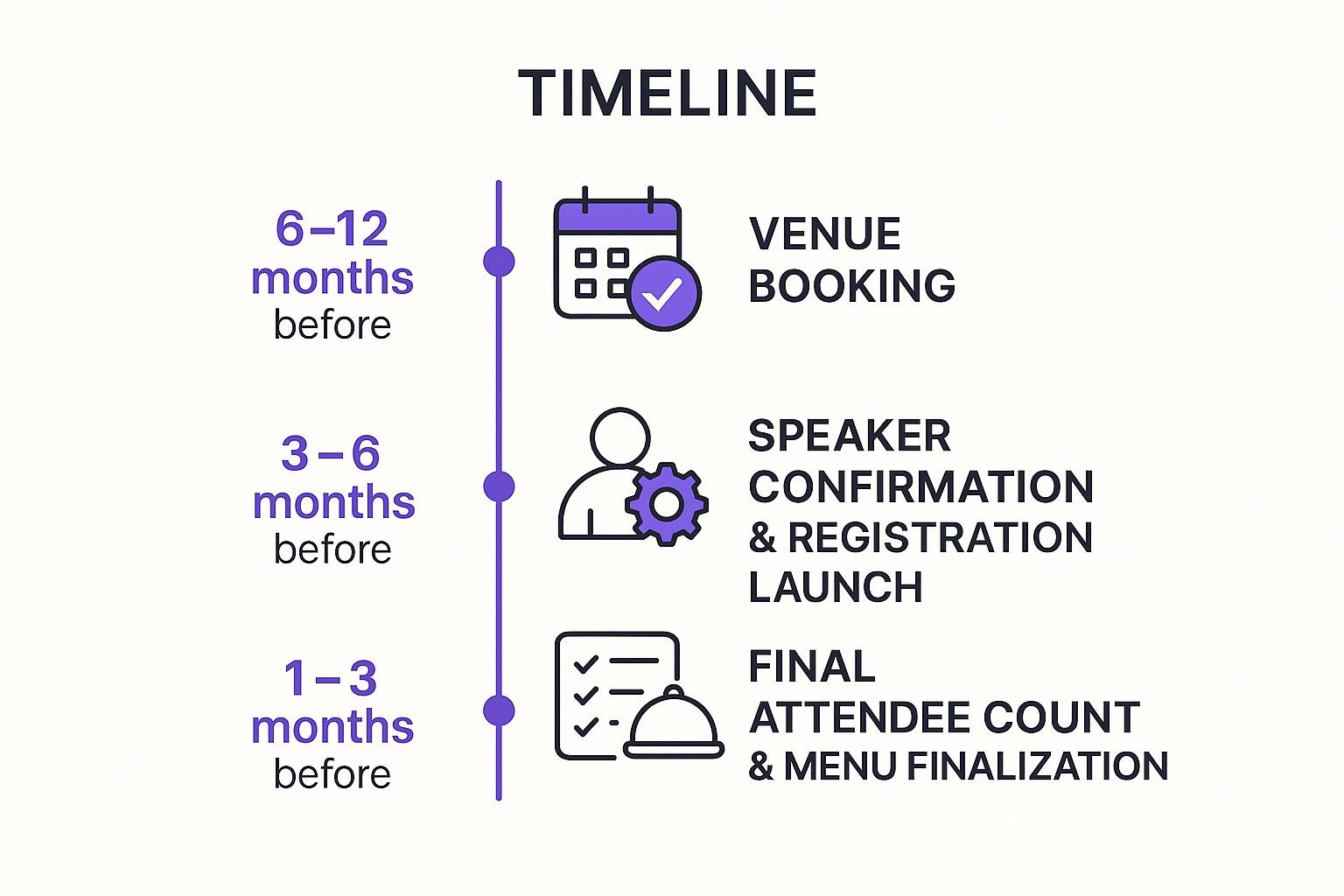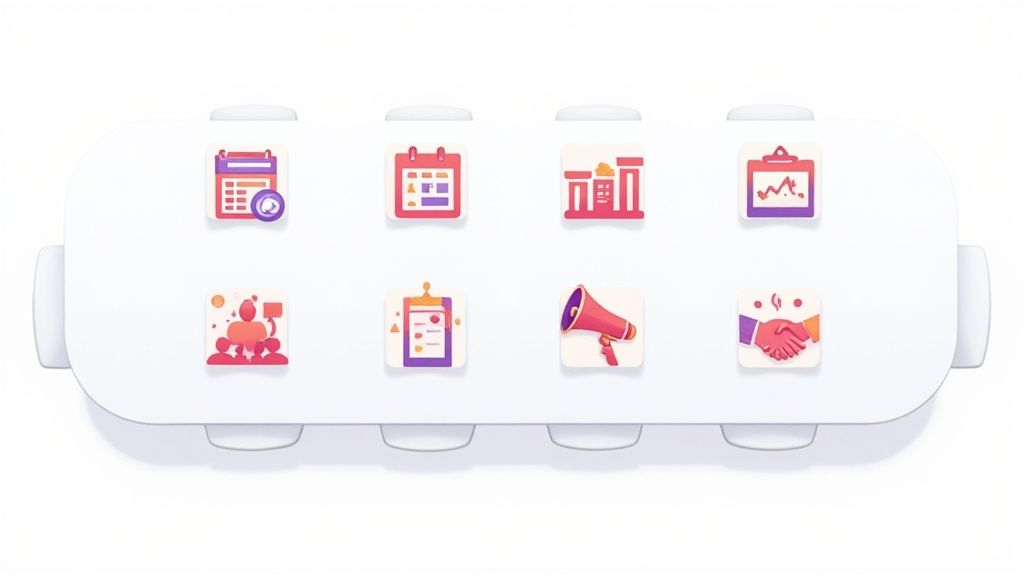Planning a corporate event, whether it's an industry-defining conference, an all-hands meeting, or a pivotal product launch, involves navigating a labyrinth of details. The pressure to deliver a seamless, impactful experience is immense. A single overlooked detail can cascade into major complications, affecting everything from attendee satisfaction and brand reputation to the ultimate return on investment. This is where a robust corporate event planning checklist becomes your most valuable asset.
It's not just a to-do list; it's a strategic framework that brings order to chaos, ensures alignment across teams, and empowers you to execute with precision. This guide provides a detailed, step-by-step roadmap to transform your vision into a resounding success. We will cover the entire lifecycle of an event, from establishing foundational goals and budgets to managing complex on-site logistics and effective post-event follow-up.
This comprehensive checklist is designed for anyone tasked with creating memorable corporate gatherings, including event marketers, small business owners, and conference organizers. We'll explore ten critical stages, offering actionable insights for each. For instance, when managing attendee communications, integrating a tool like our service, Add to Calendar PRO, can significantly boost attendance by simplifying how guests save your event details. From setting clear objectives to conducting a meticulous post-event analysis, consider this your master plan for flawless execution. Let's dive into the blueprint for your next successful corporate event.
1. Define Event Objectives and Goals
Before you book a venue or design an invitation, the most critical step in any corporate event planning checklist is to define your event's core purpose. Establishing clear, measurable objectives is the foundation upon which every subsequent decision rests. This initial phase involves identifying the primary "why" behind your event and aligning it with broader business goals to ensure a tangible return on investment.

Whether you are launching a product, fostering team collaboration, or educating clients, your objectives will dictate your budget, content, audience, and success metrics. A well-defined goal acts as a north star for your entire planning process, preventing scope creep and ensuring every element serves a specific function.
How to Implement This Step
Start by conducting stakeholder interviews with key leaders across marketing, sales, and executive teams. Ask targeted questions to uncover what success looks like to them. Use these insights to create a one-page event brief that documents your objectives.
- Quantitative Goals: These are the numbers you need to hit. Examples include generating 500 new sales leads, achieving an 80% attendance rate, or securing 25 media mentions.
- Qualitative Goals: These focus on sentiment and perception. Examples include improving employee morale, strengthening client relationships, or establishing your brand as an industry thought leader.
For example, Salesforce’s Dreamforce conference sets clear objectives for customer education and product adoption, tracking session attendance and new feature usage. Similarly, Google I/O focuses on developer engagement by measuring API adoption rates post-event.
Actionable Tips for Setting Effective Goals
To ensure your objectives are both ambitious and achievable, follow these best practices:
- Create a Hierarchy: Establish primary, secondary, and tertiary goals. This helps prioritize resources and decision-making when trade-offs are necessary.
- Establish Baselines: Before the event, measure your starting point. If your goal is to increase brand awareness, you need to know your current social media reach and sentiment.
- Align with Finance: Review objectives with finance and leadership teams early to secure buy-in and align expectations on event ROI from the outset.
- Document and Share: A shared document ensures everyone from the catering team to the keynote speaker understands the event's purpose.
2. Establish Budget and Secure Funding
With your objectives defined, the next critical step in any corporate event planning checklist is to establish a comprehensive budget and secure the necessary funding. A detailed, well-researched budget is the financial roadmap for your event, preventing overspending and ensuring that every dollar spent aligns with your strategic goals. This process involves estimating all potential costs, gaining stakeholder approval, and setting up a system for diligent expense tracking.

A well-planned budget provides clarity and control, empowering you to make informed decisions about vendors, venues, and marketing efforts. It transforms your event vision into a financially viable plan, ensuring you can deliver a high-quality experience without unexpected financial strain. From venue deposits to post-event analytics software, every line item must be accounted for to guarantee a successful outcome.
How to Implement This Step
Begin by creating a detailed spreadsheet that categorizes all anticipated expenses. Break down costs into major categories like venue, catering, technology, marketing, staffing, and entertainment. Research industry benchmarks and solicit initial quotes to ensure your estimates are realistic.
- Fixed Costs: These expenses remain the same regardless of attendee numbers, such as venue rental, speaker fees, and AV equipment hire.
- Variable Costs: These costs fluctuate based on attendance, including catering (per-person), printed materials, and attendee welcome gifts.
For instance, TED Conferences masterfully offsets significant production costs by creating tiered sponsorship packages, which provide funding while offering partners valuable exposure. Similarly, a typical corporate holiday party budget might allocate 40% to venue and catering and 20% to entertainment, providing a clear framework for spending.
Actionable Tips for Effective Budgeting
To maintain financial control throughout the planning process, adopt these best practices:
- Build in a Contingency: Allocate 10-15% of your total budget for unforeseen expenses. For first-time events, increasing this to 20% is a wise precaution.
- Get Multiple Quotes: For major expenses like venues or catering, obtain detailed proposals from at least three different vendors to ensure competitive pricing.
- Track in Real-Time: Use event management software or a shared spreadsheet to track expenses as they are incurred, allowing for immediate adjustments if you start to go over budget.
- Negotiate Payment Terms: Work with vendors to establish payment schedules that align with your company’s cash flow and funding release dates.
- Document Assumptions: Note the reasoning behind your estimates (e.g., "based on 300 attendees at $75/head for catering") so you can easily adjust if variables change.
3. Select and Book Venue
Once your objectives and budget are defined, your attention must turn to one of the most impactful decisions in the corporate event planning checklist: selecting and booking the right venue. The location you choose sets the tone for the entire event, directly influencing attendee experience, logistical feasibility, and overall brand perception. It is more than just a physical space; it’s the canvas on which your event comes to life.

The ideal venue aligns perfectly with your goals, accommodates your audience comfortably, and fits within your financial constraints. Whether you need a massive convention center for a global summit or an intimate resort for a leadership retreat, the venue must support your agenda, from technical capabilities to breakout room availability. This step requires diligent research, in-person site visits, and sharp negotiation skills to secure a space that elevates your event.
How to Implement This Step
Begin by creating a short list of potential venues based on your event's non-negotiables: capacity, location, and budget. Conduct site visits for your top contenders to assess the space in person. During the visit, evaluate everything from parking and accessibility to lighting and acoustics. Once you've identified the perfect spot, carefully review the contract, paying close attention to cancellation policies, insurance requirements, and included amenities before signing.
- Large-Scale Conferences: For events like the Amazon Web Summit, which attracts over 50,000 attendees, only massive venues like the Las Vegas Convention Center can provide the necessary scale, flexible exhibition halls, and numerous breakout rooms.
- Corporate Retreats: Companies aiming for immersive team-building experiences often select all-inclusive resorts like The Broadmoor or The Greenbrier, which offer meeting spaces, lodging, and recreational activities in one package.
- Brand-Centric Events: Tech giants like Facebook and LinkedIn often host events at their own corporate campuses to reinforce brand identity, control the environment, and provide attendees with a behind-the-scenes look.
Actionable Tips for Securing the Right Venue
To avoid common pitfalls and ensure your chosen venue is a perfect fit, follow these best practices:
- Visit in Person: Never book a venue based solely on photos or virtual tours. An in-person visit is essential to gauge the true atmosphere, layout, and condition of the space.
- Inquire About Hidden Fees: Ask for a complete cost breakdown to uncover potential extra charges for security, setup, cleaning, or overtime, which can significantly inflate your budget.
- Verify Technical Capabilities: Confirm that the venue’s Wi-Fi, AV equipment, and power supply can handle your specific technical requirements, especially for hybrid events or tech-heavy presentations.
- Negotiate Contract Clauses: Pay special attention to attrition clauses for hotel room blocks and force majeure clauses for unforeseen cancellations. Don't be afraid to negotiate terms that protect your organization.
4. Develop Event Timeline and Master Schedule
With your objectives defined and budget set, the next crucial component of your corporate event planning checklist is creating a master timeline. This detailed schedule acts as your project plan, mapping out every task from initial brainstorming to post-event analysis. It ensures all moving parts are coordinated, deadlines are met, and nothing falls through the cracks.
A well-structured timeline is divided into two key parts: the long-term planning schedule and the day-of run-of-show. The planning schedule outlines key milestones and assigns responsibilities, while the run-of-show coordinates every on-site activity down to the minute. This master document prevents last-minute chaos and aligns your entire team, from vendors to volunteers.
How to Implement This Step
Begin by working backward from your confirmed event date. List every major milestone, such as venue selection, speaker confirmation, and registration launch, and assign deadlines. Use project management software like Asana or Monday.com to create a shared, dynamic timeline that tracks progress and dependencies.
- Planning Timeline: This macro-level view should cover the 6-12 months leading up to the event. Key phases include vendor sourcing, marketing campaign launches, and content development.
- Run-of-Show: This micro-level schedule details the event day itself. It should include everything from vendor arrival and setup times to presentation start times, breaks, and breakdown procedures.
For instance, Apple's meticulously planned product keynotes follow a precise run-of-show, with every second allocated for speaker transitions and product demos. Similarly, large-scale conferences like South by Southwest (SXSW) manage thousands of sessions by creating coordinated schedules for each venue, speaker, and support team.
The following infographic illustrates the key milestones in a typical corporate event planning timeline, helping you visualize the critical path to success.

This visual guide highlights how major decisions, like booking a venue, must be made early, creating a foundation for subsequent tasks like speaker outreach and attendee registration.
Actionable Tips for Effective Scheduling
To build a timeline that keeps your planning on track, implement these best practices:
- Build in Buffers: Add a 15-minute buffer between major program segments in your run-of-show to accommodate potential delays without derailing the entire schedule.
- Create Stakeholder-Specific Versions: Provide tailored schedules for different groups (e.g., speakers, vendors, volunteers) so they only see the information relevant to them.
- Designate a Timekeeper: Assign a specific person the responsibility of keeping the event running on schedule during the day-of execution.
- Use a Template: A pre-built schedule is an excellent starting point. Learn more about how to create an effective plan with a detailed event planning timeline template.
5. Plan Catering and Food & Beverage Service
Often consuming 25-30% of the total budget, food and beverage (F&B) planning is far more than just a line item; it's a critical component of the attendee experience. Thoughtful catering can elevate an event from good to memorable, while a poorly executed F&B plan can detract from even the most compelling content. This step in your corporate event planning checklist involves selecting menus, accommodating dietary needs, and coordinating service logistics.
The right culinary approach enhances networking, sustains energy levels, and reflects your brand's commitment to quality. From formal sit-down dinners to casual food truck rallies, your catering choices should align with your event's objectives, audience, and overall tone, making attendees feel valued and well-cared for.
How to Implement This Step
Begin by aligning your F&B strategy with your event's schedule and goals. Consult with your venue's catering manager or external caterers early to understand their capabilities, menu options, and pricing structures. The key is to integrate F&B planning into the registration process to gather crucial data upfront.
- Dietary Accommodation: Use your registration form to collect specific dietary restrictions and allergies (e.g., gluten-free, vegan, nut allergies). This data is essential for accurate menu planning and ensures a safe, inclusive experience for all guests.
- Service Style: Choose a service style that fits your event's flow. A buffet might work for a relaxed lunch, while passed hors d'oeuvres are better for a standing networking reception. Consider the logistical impact of each choice on traffic flow and timing.
For instance, Google events are known for creative, locally-sourced menus with extensive, clearly labeled dietary options. Meanwhile, Salesforce's Dreamforce uses food trucks and varied grab-and-go stations to facilitate informal networking and manage large crowds efficiently.
Actionable Tips for Effective F&B Planning
To ensure your catering is a highlight rather than a headache, apply these strategic practices:
- Schedule a Tasting: Never finalize a menu without tasting it first. This is your chance to assess quality, presentation, and portion sizes.
- Avoid Messy Foods: For networking-focused segments, choose handheld, easy-to-eat items that don't require extensive cutlery or create potential for spills.
- Plan for Energy Flow: Schedule coffee and water stations to be available throughout the day. Time your meals and snacks strategically to prevent the common mid-afternoon energy slump.
- Buffer Your Numbers: Order 5-10% more meals than your final RSVP count to accommodate last-minute attendees. It's also wise to plan for 10-15% more vegetarian or vegan options than requested, as they are often popular choices.
6. Coordinate Audio-Visual and Technology Requirements
In the digital age, technology infrastructure is the backbone of a successful corporate event. Overlooking audio-visual (AV) and tech needs can lead to presentation failures, poor attendee engagement, and a damaged brand reputation. This crucial step involves a thorough assessment of all technological requirements, from sound systems and projectors to internet connectivity and live-streaming capabilities.
Whether you are hosting an intimate workshop or a large-scale hybrid conference, the right technology ensures your content is delivered flawlessly and your audience remains connected. A well-planned tech stack elevates the attendee experience, supports speakers, and enables seamless execution, making it a non-negotiable part of any modern corporate event planning checklist.
How to Implement This Step
Begin by creating a detailed tech inventory based on your event agenda and format. List every session, speaker, and engagement activity, then map out the specific AV and IT requirements for each. This includes microphones, screens, lighting, cameras for recording or streaming, and any interactive tools like audience polling apps.
- AV & Production: Define your needs for sound reinforcement, visual displays, stage lighting, and session recording. Specify equipment types, such as lavalier vs. handheld mics or LED walls vs. standard projectors.
- IT & Connectivity: Determine your internet requirements. High-density Wi-Fi is essential for attendees, but a dedicated, hardwired connection is critical for your production team, live stream, and registration systems.
For example, the massive CES conference utilizes sophisticated LED walls and immersive AV experiences to create a futuristic atmosphere. Similarly, Cisco Live must provide flawless, high-speed connectivity for thousands of tech-savvy attendees using multiple devices simultaneously, demonstrating the power of its own networking solutions.
Actionable Tips for Flawless Tech Execution
To avoid last-minute technical glitches and ensure a smooth experience, integrate these best practices into your planning:
- Hire Professionals: For any event beyond a small meeting, contract an experienced AV company. Their expertise is invaluable for planning, setup, and on-site troubleshooting.
- Conduct a Full Rehearsal: Schedule a complete technical run-through with all presenters, using the actual event equipment in the venue. Test every video, slide deck, and audio cue.
- Request Dedicated Bandwidth: Never rely on shared hotel or venue Wi-Fi for mission-critical functions. Purchase a dedicated internet line for your production and registration teams.
- Plan for Contingencies: Pack a backup kit with extra cables, batteries, adapters, and even a spare projector. Murphy’s Law often applies to event tech.
- Consider Accessibility: Integrate technology that makes your event accessible to all, such as live captioning services, assistive listening devices, and audio descriptions for visual content.
7. Manage Registration and Attendee Communications
Once your event is taking shape, the next pivotal step in your corporate event planning checklist is to create a seamless system for managing registration and communicating with attendees. This process is the first direct interaction potential guests have with your event, making it a critical touchpoint for setting a professional, organized tone. Effective registration and communication drive attendance, minimize confusion, and build excitement leading up to the event day.
From selecting the right technology platform to deploying a strategic communication schedule, this phase ensures attendees feel informed and valued. A well-executed registration experience simplifies data collection for you and provides a frictionless journey for your guests, ensuring they arrive prepared, engaged, and ready to participate.
How to Implement This Step
Begin by selecting a registration platform that aligns with your event's complexity and integrates with your existing marketing or CRM systems. Create a clear, user-friendly registration workflow that captures necessary attendee data without being cumbersome. Simultaneously, develop a communication calendar that outlines key touchpoints from the moment registration opens until post-event follow-up.
- Registration Management: This involves setting up ticket types (e.g., early bird, VIP, general admission), processing payments securely, and managing attendee information. The goal is to make signing up as easy as possible.
- Attendee Communications: This includes a series of automated and manual emails, such as registration confirmations, event reminders, agenda updates, and "know before you go" logistics.
For example, HubSpot’s INBOUND conference integrates registration directly with its CRM, allowing for seamless data flow and highly personalized attendee communications. Similarly, Salesforce’s Dreamforce uses a custom app to manage its complex registration process and deliver AI-powered session recommendations, enhancing the pre-event experience.
Actionable Tips for Effective Registration and Communication
To optimize this crucial stage and maximize attendance, implement these proven strategies:
- Launch Strategically: Open registration 3-6 months in advance for large events and offer early bird pricing to create a sense of urgency and drive initial sign-ups.
- Communicate Consistently: Create a communication calendar with 6-8 planned touchpoints. Send an immediate confirmation email upon registration, followed by regular updates and a final logistics email 3-5 days before the event.
- Segment Your Audience: Tailor your messages based on attendee type, such as speakers, sponsors, or VIPs. Personalized content is far more effective than generic blasts.
- Test Everything: Before going live, thoroughly test the entire registration process from the user's perspective to identify and fix any potential friction points. For a deeper dive into streamlining this process, you can learn more about event registration best practices on add-to-calendar-pro.com.
8. Secure Speakers, Entertainment, and Program Content
Once your venue is secured, the next major piece of your corporate event planning checklist is the content itself. The speakers, entertainment, and agenda are the heart of the attendee experience and the primary vehicles for delivering on your event objectives. This step involves identifying, vetting, and booking presenters and performers who align with your theme, resonate with your audience, and deliver tangible value.
Whether you are featuring internal leaders, industry experts, or a high-profile keynote, your content strategy dictates the event's overall impact and memorability. A well-curated program engages attendees, reinforces key messages, and creates the buzz needed to achieve your goals. Rushing this stage often leads to disjointed sessions and a disengaged audience.
How to Implement This Step
Begin by creating a content map that aligns each session or performance with a specific event goal. Research potential speakers based on expertise, stage presence, and relevance to your audience. For entertainment, consider how it complements the event's tone, whether it’s a local band for networking or a major headliner for a user conference.
- Internal Speakers: Leverage the expertise within your organization. Brief executives and subject matter experts on session goals and audience expectations to ensure their content is polished and relevant.
- External Speakers: For keynotes or specialized topics, engage industry influencers or professional speakers. Use speaker bureaus or direct outreach, but always review past speaking engagements to vet their quality and style.
- Entertainment: Book performers that match the event's energy. Salesforce’s Dreamforce, for instance, famously includes major musical acts like Metallica and Janet Jackson to create a memorable, festival-like atmosphere.
For example, TED's rigorous speaker selection and coaching process ensures every 18-minute talk is impactful and shareable. Similarly, corporate sales kickoffs often book motivational speakers like Simon Sinek to inspire their teams for the year ahead.
Actionable Tips for Securing Great Content
To build a compelling and seamless program, follow these best practices:
- Book Keynotes Early: Secure high-demand keynote speakers 6 to 12 months in advance, as their schedules fill up quickly.
- Provide Detailed Briefs: Give every speaker a comprehensive brief outlining the audience profile, key takeaways, session length, and logistical details.
- Conduct Rehearsals: Schedule virtual run-throughs with all speakers, especially external ones, to test technology and review content flow.
- Assign a Liaison: Designate a single point of contact for each speaker to manage their travel, on-site needs, and questions, ensuring a VIP experience.
- Clarify Content Rights: Ensure your speaker contracts clearly define the rights to record, reproduce, and distribute their presentation content post-event.
9. Develop Marketing and Promotional Strategy
Once your event's core elements are in place, the focus must shift to driving attendance and building excitement. A strategic marketing and promotional plan is not an afterthought; it is a critical component of your corporate event planning checklist that ensures your message reaches the right audience at the right time. This multifaceted task involves creating a cohesive brand, executing multi-channel campaigns, and maintaining momentum from the first announcement to the event day.
Effective promotion generates registrations, but great promotion builds a community and creates a sense of FOMO (Fear of Missing Out). Your strategy will dictate how your event is perceived, who attends, and the level of engagement you can expect before, during, and after the event. A well-executed plan amplifies your event’s value and is essential for achieving your attendance and ROI goals.
How to Implement This Step
Begin by defining your target audience personas and crafting key messaging that resonates with their pain points and aspirations. Develop a promotional calendar that outlines all activities across different channels, from email marketing and social media to paid advertising and content marketing.
- Multi-Channel Execution: Deploy a mix of organic and paid tactics. Use targeted LinkedIn campaigns to reach specific job titles, engaging Instagram stories to showcase behind-the-scenes content, and a consistent email nurture sequence to guide prospects from awareness to registration.
- Content is King: Create valuable content that previews the event's substance. This can include blog posts from speakers, short video interviews, or sneak peeks of the agenda. This content serves as promotional fuel for all your channels.
For example, SXSW excels at leveraging user-generated content, encouraging attendees to share their excitement and creating a powerful organic marketing engine. Similarly, Apple's product launches generate massive media buzz with a highly secretive, minimalist promotional strategy that builds immense anticipation. To learn more, see our detailed guide on creating a successful event marketing plan.
Actionable Tips for Effective Promotion
To maximize your marketing impact and ensure a sold-out event, integrate these best practices:
- Start Early: Begin promotional activities at least 4-6 months before the event to build a strong pipeline of interested attendees.
- Create Urgency: Implement early-bird pricing deadlines and use messaging that highlights limited capacity to encourage prompt registration.
- Leverage Video: Use video content for speaker announcements, venue tours, and testimonials; it consistently drives higher engagement than static posts.
- Create a Unique Hashtag: Establish a clear, concise event hashtag and use it across all communications to centralize the social conversation.
- Track Everything: Use UTM codes on all your promotional links to accurately measure which channels are driving the most registrations and optimize your spending accordingly.
10. Plan Event Logistics and Day-Of Operations
While strategy and promotion are vital, the success of your corporate event ultimately hinges on flawless day-of execution. This critical step in your corporate event planning checklist involves creating a meticulous operational plan that covers every logistical detail, from attendee check-in and transportation to security protocols and vendor management. A well-oiled operational machine ensures a seamless, positive experience for attendees and empowers your team to handle any unexpected challenges with confidence.
Failing to plan logistics can lead to long queues, confused guests, and technical glitches that undermine your event's objectives. A comprehensive day-of operations plan is the blueprint that guides your entire team, ensuring every individual knows their role and every potential issue has a predetermined solution. It's the behind-the-scenes framework that makes complex events feel effortless.
How to Implement This Step
Begin by creating a master document known as a "run-of-show" or production schedule. This minute-by-minute timeline details every activity from the first vendor arrival to the final breakdown. Share this document with all staff, volunteers, and vendors so everyone is synchronized. Establish a central command station on-site to act as the nerve center for communication and decision-making.
- Staffing & Communication: Define clear roles and responsibilities for every team member. Equip staff with two-way radios or a dedicated messaging app (like Slack or WhatsApp) for real-time updates and problem-solving.
- Attendee Flow: Map out the entire guest journey, including parking, registration, navigating the venue, and exiting. Use clear, professionally produced signage and wayfinding aids to guide attendees smoothly.
For instance, major conferences like SXSW manage massive crowds by using a tiered credentialing system, color-coded staff vests for different functions, and a central operations center to coordinate everything from stage management to security in real time. Similarly, Coachella effectively manages 125,000 attendees daily through detailed logistical protocols and command structures.
Actionable Tips for Flawless Operations
To ensure your event runs smoothly from start to finish, integrate these best practices into your plan:
- Create a Run-of-Show: Develop a detailed, minute-by-minute schedule and distribute it to all stakeholders, including vendors, speakers, and staff.
- Conduct a Final Walk-Through: Tour the venue with key team leads 24-48 hours before the event to finalize layouts, check tech, and identify potential issues.
- Hold a Pre-Event Briefing: Gather your entire on-site team before doors open to review roles, the schedule, communication protocols, and emergency procedures.
- Prepare Contingency Plans: Brainstorm potential problems like bad weather, a speaker no-show, or a power outage, and create a clear action plan for each scenario.
Corporate Event Planning Checklist Comparison
| Item | Implementation Complexity 🔄 | Resource Requirements ⚡ | Expected Outcomes 📊 | Ideal Use Cases 💡 | Key Advantages ⭐ |
|---|---|---|---|---|---|
| Define Event Objectives and Goals | Medium: Involves multiple stakeholders and iterative refinement | Low to Medium: Mostly planning and alignment efforts | Clear direction, measurable success, ROI tracking | All corporate events needing strategic focus | Provides direction, prevents scope creep, aligns stakeholders |
| Establish Budget and Secure Funding | High: Detailed cost tracking and negotiation needed | High: Requires financial data, vendor quotes, contingency funds | Controlled spending, financial accountability | All events with defined financial limits | Prevents overspending, enables vendor negotiation, transparent finances |
| Select and Book Venue | Medium to High: Research, site visits, contract negotiation | Medium to High: Requires time, travel, and negotiation resources | Suitable venue secured, attendee comfort ensured | Events requiring physical location matching objectives | Enhances brand image, sets event tone, offers bundled services |
| Develop Event Timeline and Schedule | Medium: Complex scheduling and task tracking | Low to Medium: Planning tools and team coordination | Smooth event flow, clear accountability | Events with multiple milestones and vendors | Reduces stress, identifies bottlenecks early, facilitates coordination |
| Plan Catering and Food & Beverage | Medium: Menu planning and service logistics | Medium to High: Catering costs and dietary accommodations | Enhanced attendee satisfaction and engagement | Events with meal services or receptions | Improves networking, energizes attendees, reflects company culture |
| Coordinate Audio-Visual and Tech | High: Technical setup, rehearsals, redundancies | High: Equipment, vendor expertise, technical staff | Professional presentations, hybrid/virtual capabilities | Tech-heavy, hybrid, or high-profile speaker events | Enhances message delivery, enables interaction, supports streaming |
| Manage Registration & Communications | Medium: Platform setup and multi-touch communications | Medium: Software platforms and data management | Higher registrations, engaged and informed attendees | Events needing scalable attendee management | Streamlines registration, personalizes engagement, provides valuable data |
| Secure Speakers, Entertainment & Content | High: Speaker sourcing, contracts, content quality control | Medium to High: Fees, logistics, rehearsal time | Engaging content, higher attendance, post-event assets | Conferences, product launches, motivational events | Drives attendance, adds prestige, provides content value |
| Develop Marketing & Promotional Strategy | High: Multi-channel campaigns, content creation, analytics | Medium to High: Budget and marketing resources | Increased visibility and registrations | Events requiring broad or targeted outreach | Builds buzz, drives registration, measurable ROI |
| Plan Event Logistics & Day-Of Ops | High: Extensive coordination and contingency planning | High: Staffing, vendor management, communications | Smooth operations, positive attendee experience | Large-scale or complex events requiring detailed execution | Prevents chaos, maximizes efficiency, enables quick issue resolution |
Bringing It All Together for Lasting Impact
Successfully navigating the complexities of corporate event planning is a formidable task, but it’s one that transforms from daunting to manageable with a structured, systematic approach. This comprehensive corporate event planning checklist has guided you through every critical stage, from defining your core objectives and establishing a realistic budget to orchestrating the intricate dance of day-of logistics and post-event analysis. Each step, from venue selection to marketing strategy, is a vital piece of a larger, interconnected puzzle.
Remember that the ultimate goal extends beyond a single, flawless event. The true measure of success lies in the lasting impact your event creates. It’s about forging stronger connections with your audience, reinforcing your brand’s message, and delivering tangible value that resonates long after the final session concludes. By diligently following this framework, you are not just organizing an event; you are architecting a memorable experience designed to achieve specific business outcomes.
From Checklist to Cohesive Strategy
The true power of this checklist is realized when you move from simply ticking off boxes to integrating each element into a cohesive, fluid strategy. The most successful event planners understand that these components do not exist in isolation.
- Interconnectivity is Key: Your budget directly influences your venue and catering options. Your event goals shape your speaker selection and content programming. Your marketing strategy must align perfectly with your attendee registration process. Recognizing these dependencies allows you to make smarter, more informed decisions and pivot effectively when challenges arise.
- Communication as the Lifeline: Throughout the planning process, clear and consistent communication is your most valuable asset. This extends to your internal team, your external vendors, your stakeholders, and, most importantly, your attendees. A breakdown in communication can quickly derail even the best-laid plans.
Key Insight: A checklist provides the "what," but a cohesive strategy informed by constant communication provides the "how." It’s the difference between merely executing tasks and orchestrating a symphony where every instrument plays its part in perfect harmony.
Bridging the Gap Between Registration and Attendance
One of the most common friction points in event planning is the gap between a successful registration and actual attendance. You can invest thousands in promotion, secure world-class speakers, and plan a phenomenal agenda, but it all falls short if attendees forget to show up. This is where modern, user-centric tools become indispensable.
Simplifying the path from "I'm interested" to "It's on my calendar" is a critical, yet often overlooked, step in the attendee journey. Our service, for instance, directly addresses this challenge by enabling you to embed clean, simple 'Add to Calendar' buttons directly into your confirmation emails, landing pages, and promotional materials. This single click empowers your audience to save all the crucial event details to their personal digital calendar, complete with reminders. This simple action dramatically reduces no-show rates and ensures your event remains a priority in a crowded schedule. A robust corporate event planning checklist should always include tactical solutions that secure the ROI you've worked so diligently to build.
Ultimately, your dedication to meticulous planning, from the initial concept to the final follow-up email, is what elevates a standard corporate function into a powerful, brand-building experience. Use this guide as your roadmap, adapt it to your unique needs, and empower yourself with the right tools to ensure every detail is handled with precision. By doing so, you are not just planning an event; you are creating a catalyst for growth, engagement, and lasting business relationships.
Ready to ensure every registration turns into an engaged attendee? Start a free trial of Add to Calendar PRO and see how easy it is to add one-click calendar buttons to your event communications. Visit Add to Calendar PRO to enhance your event planning checklist and maximize your attendance rates today.



